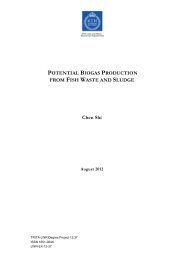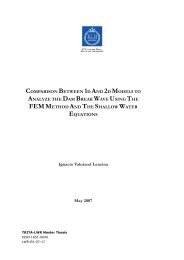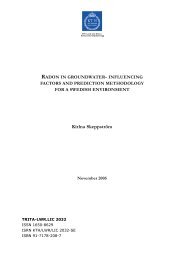Mat<strong>the</strong>w Biniyam KursahTRITA LWR Master Thesis<strong>and</strong> <strong>the</strong> 70+ years to <strong>the</strong>ir lists, 4) age inflation or reduction to benefitfrom <strong>the</strong> free registration, <strong>and</strong> 5) extremely high hospital bills formembers <strong>of</strong> <strong>the</strong> scheme (Box 4). Therefore, <strong>the</strong> problem <strong>of</strong> <strong>the</strong> healthscheme is simply resource constraint <strong>and</strong> fraud from <strong>the</strong> public. NHIS isurged to engage in effective health awareness programmes since it willbenefit immensely from good health <strong>of</strong> <strong>the</strong> public – less hospital bills.Political <strong>and</strong> gender issuesDuring <strong>the</strong> field study, I did not find any concrete <strong>water</strong> policy in <strong>the</strong>district. The study revealed that customary laws are more wholistic inmanaging <strong>and</strong> protecting <strong>water</strong> re<strong>sources</strong> in <strong>the</strong> district than governmentor district laws. Customary laws are also widely known <strong>and</strong> obeyed with41.8% <strong>of</strong> <strong>the</strong> respondents believed it was highly effective , 36.1%(medium) <strong>and</strong> only 22.1% rated it as lowly effective; compared to 6.5%,44% <strong>and</strong> 49.5% for high, medium <strong>and</strong> low, respectively, for governmentor district laws (Fig. 5). Also, 15.4% <strong>of</strong> <strong>the</strong> respondent said <strong>the</strong>re are nogovernment or district laws protecting <strong>water</strong> re<strong>sources</strong> in <strong>the</strong> district asagainst 2.3% for customary laws (Table 8). This is because customarylaws are seen to have come from <strong>the</strong> people by <strong>the</strong> people <strong>and</strong> for <strong>the</strong> people. Thisanalysis <strong>the</strong>refore questions, as many have done, <strong>the</strong> effectiveness <strong>of</strong> topdownapproach to policy formulation <strong>and</strong> implementation.The study also discovered that women do not actively participate indecision making <strong>and</strong> issues concerning <strong>the</strong> communities. This was clearlyseen during <strong>the</strong> administration <strong>of</strong> questionnaires where women referredme to direct <strong>the</strong> questions to <strong>the</strong>ir men counterpart. In most cases(mostly in villages) <strong>the</strong> women had to first seek permission from men orhusb<strong>and</strong>s before being interviewed – partly why <strong>the</strong>y were underrepresented in <strong>the</strong> sampling. The study also discovered that women weredisproportionately affected by <strong>water</strong> related diseases as more than half(54.2%) <strong>of</strong> <strong>the</strong> patients diagnosed <strong>of</strong> <strong>water</strong>-related disease in SMC werewomen compared to 45.8% for men. Also, more women (54.5%) thanmen (45.5%) reported with RTI. However, a sharp reverse is <strong>the</strong> case foro<strong>the</strong>r diseases, as 54.5% were men <strong>and</strong> 45.5% being women. Theexplanation is that generally, more men have access to <strong>the</strong> defencemechanisms against environmental hazards (Fig. 2) due to <strong>the</strong>ir control<strong>of</strong> re<strong>sources</strong> <strong>and</strong> power in <strong>the</strong> family. However, data from WHC showlesser proportion <strong>of</strong> women (51.5%), but still higher compared to men(48.5%). This may be due to <strong>the</strong> non-treatment <strong>of</strong> disease like Typhoidat WHC <strong>and</strong> physical accessibility (long distances). For o<strong>the</strong>r diseases,just like in SMC, a sharp contrast occurred with 57.9% being men <strong>and</strong>42.1% women. WHC data also shows that Genital <strong>and</strong> STIspredominantly affects women (60.0%) than men (40.0%).Causes <strong>of</strong> high prevalence <strong>of</strong> environmental diseases in Saboba districtThe study identified a number <strong>of</strong> factors that have predisposed Sabobadistrict to higher rates <strong>of</strong> <strong>water</strong>-related (<strong>and</strong> in general, environmentaldiseases) such as Malaria <strong>and</strong> Typhoid in Saboba district. Many <strong>of</strong> <strong>the</strong>causes are synergic in character as discussed below;Presence <strong>of</strong> dugout pits created by <strong>the</strong> large use <strong>of</strong> mud or earth (94.2%) as<strong>the</strong> main building material <strong>and</strong> <strong>the</strong>ir subsequent fill-up with <strong>water</strong> duringrainy season has made it possible for mosquito larvae to breed. The use<strong>of</strong> such pits as a place <strong>of</strong> toilet (free-range) <strong>and</strong> <strong>sources</strong> <strong>of</strong> <strong>water</strong> fur<strong>the</strong>rexplains <strong>the</strong> high occurrence <strong>of</strong> Typhoid. Closely related to this, is <strong>the</strong>presence <strong>of</strong> stagnant <strong>water</strong> found in potholes, disposed tin cans, brokencalabashes <strong>and</strong> o<strong>the</strong>r containers.56
Water <strong>sources</strong>, <strong>infrastructure</strong>, <strong>space</strong> <strong>and</strong> <strong>the</strong> <strong>dynamics</strong> <strong>of</strong> environmental diseases in Saboba District: Using GISConclusionGrowing population <strong>and</strong> inadequacy <strong>of</strong> toilet facilities, including uncleanness <strong>of</strong><strong>the</strong> few existing public ones have pushed 91.1% <strong>of</strong> <strong>the</strong> population to use<strong>the</strong> free-range system resulting in increasing rates <strong>of</strong> Typhoid. This laidcredence to IWMI (2000) view stated above.Inadequacy <strong>of</strong> clean or treated <strong>water</strong> <strong>and</strong> frequent interruption in <strong>the</strong> flow <strong>of</strong> pipe<strong>water</strong> is identified as ano<strong>the</strong>r causal factor for <strong>the</strong> high incidences <strong>of</strong><strong>water</strong> related diseases in Saboba district. Even with <strong>the</strong> presence <strong>of</strong> pipeborne <strong>water</strong> in <strong>the</strong> district, majority <strong>of</strong> <strong>the</strong> population still drink <strong>water</strong>from unimproved <strong>sources</strong> as 50.2% drink <strong>water</strong> from streams or springsor rivers, 12.7% (dugout pits) <strong>and</strong> 12.4% from Wells. Only 17.2% <strong>of</strong><strong>the</strong> total population in <strong>the</strong> district drink <strong>water</strong> from boreholes <strong>and</strong> 7.4%from pipes (improved <strong>sources</strong>). The high proportion <strong>of</strong> unimproved<strong>sources</strong> <strong>of</strong> <strong>water</strong> is due to 1) lack <strong>of</strong> access to pipes <strong>and</strong> boreholes formany communities, 2) frequent interruption in existing pipe <strong>water</strong>supply, 3) disconnection <strong>of</strong> pipes due to non-payment <strong>of</strong> <strong>water</strong> bills, <strong>and</strong>4) many people especially from <strong>the</strong> periphery will not drink borehole<strong>water</strong> because it is too light <strong>and</strong> does not quench taste or smells badly.The research also discovered lack <strong>of</strong> waste disposal system as responsible for<strong>the</strong> high environmental diseases in <strong>the</strong> district, as 92% uses unimprovedmethods <strong>of</strong> waste disposal such as dump elsewhere, burn <strong>and</strong> buried methods.The indiscriminate <strong>and</strong> large dumping <strong>of</strong> used tin-cans, broken calabash <strong>and</strong>poly<strong>the</strong>ne bags in <strong>the</strong> district are also found to contain <strong>water</strong> for a long timeafter rain, serving as reservoir for breeding mosquito larvae. Openedunderground tanks <strong>and</strong> public toilets also breeds a lot <strong>of</strong> mosquitoes(Appendix IV f <strong>and</strong> Fig. 15b)Poverty has also been identified as one o<strong>the</strong>r cause <strong>of</strong> high environmentaldiseases in <strong>the</strong> district. Poverty accounted for why people cannot pay<strong>the</strong>ir <strong>water</strong> bills leading to disconnection <strong>of</strong> pipes. It is also responsiblefor high illiteracy, inability (financially) to acquire a personal toilet facility<strong>and</strong> <strong>the</strong> general lack <strong>of</strong> defence mechanisms shown in <strong>the</strong> conceptualframework.Illiteracy <strong>and</strong> ignorance have it part to blame for <strong>the</strong> high incidences <strong>of</strong><strong>water</strong> related diseases, <strong>and</strong> environmental diseases in general. Complainsthat borehole <strong>water</strong> is too light <strong>and</strong> does not quench thirst were largely seen tobe more perceptual, <strong>and</strong> a consequent <strong>of</strong> ignorance than reality.The free-range system <strong>of</strong> animal rearing, especially pigs, have resulted inanimals dump littered almost every where, while some share <strong>the</strong> samesource <strong>of</strong> <strong>water</strong> with humans. Their faecal matter is easily washed into<strong>water</strong> bodies, while some create potholes or drainage blockage thatfacilitates <strong>the</strong> breeding <strong>of</strong> mosquitoes (Appendix IV c).The cause <strong>of</strong> high rates <strong>of</strong> RTI may be <strong>the</strong> use <strong>of</strong> woodfuel for cooking,bushfires, <strong>the</strong> inappropriate use <strong>of</strong> mosquito coils or plant matter <strong>and</strong>dust from <strong>the</strong> Harmattan. The effect <strong>of</strong> environmentally unfriendly cars<strong>and</strong> lorries on RTI in <strong>the</strong> district does not seem to play an importantrole, due to fewer cars <strong>and</strong> <strong>the</strong> rough nature (potholes) <strong>of</strong> <strong>the</strong> roads.Generally, <strong>the</strong> higher rate <strong>of</strong> environmental diseases in Saboba district islargely a human induced phenomenon; hence natural causes have verylimited impact. The study discovered that <strong>the</strong> immediate environmentalthreats for <strong>the</strong> people <strong>of</strong> Saboba district may not be <strong>the</strong> long-term effects<strong>of</strong> cumulative exposure to carcinogens or/<strong>and</strong> effects <strong>of</strong> global warming,or even decade-long desertification but ra<strong>the</strong>r <strong>the</strong> life <strong>and</strong> deathimmediacy <strong>of</strong> Malaria, Typhoid <strong>and</strong> respiratory diseases. These threatsare mainly synergic human factors derived from household57
- Page 1 and 2:
Supervisor: Ulla MortbergCo-supervi
- Page 3 and 4:
Water sources, infrastructure, spac
- Page 5 and 6:
Water sources, infrastructure, spac
- Page 7 and 8:
Water sources, infrastructure, spac
- Page 9 and 10:
Water sources, infrastructure, spac
- Page 11 and 12:
Water sources, infrastructure, spac
- Page 13 and 14:
Water sources, infrastructure, spac
- Page 15 and 16:
Water sources, infrastructure, spac
- Page 17 and 18:
Matthew Biniyam KursahTRITA LWR Mas
- Page 19 and 20:
Matthew Biniyam KursahTRITA LWR Mas
- Page 21 and 22: Matthew Biniyam KursahTRITA LWR Mas
- Page 23 and 24: Matthew Biniyam KursahTRITA LWR Mas
- Page 25 and 26: OberadeYusungaManieBilyimbaMatthew
- Page 27 and 28: Matthew Biniyam KursahTRITA LWR Mas
- Page 29 and 30: Matthew Biniyam KursahTRITA LWR Mas
- Page 31 and 32: Matthew Biniyam KursahTRITA LWR Mas
- Page 33 and 34: Matthew Biniyam KursahTRITA LWR Mas
- Page 35 and 36: Matthew Biniyam KursahTRITA LWR Mas
- Page 37 and 38: Matthew Biniyam KursahTRITA LWR Mas
- Page 39 and 40: Matthew Biniyam KursahTRITA LWR Mas
- Page 41 and 42: PercentagePercentageMatthew Biniyam
- Page 43 and 44: Matthew Biniyam KursahTRITA LWR Mas
- Page 45 and 46: Matthew Biniyam KursahTRITA LWR Mas
- Page 47 and 48: Matthew Biniyam KursahTRITA LWR Mas
- Page 49 and 50: BilyimbaMatthew Biniyam Kursah Nadu
- Page 51 and 52: ManieBilyimbaBaguliMatthew Biniyam
- Page 53: ManieBilyimbaMatthew Biniyam Kursah
- Page 56 and 57: Matthew Biniyam KursahTRITA LWR Mas
- Page 58 and 59: Matthew Biniyam KursahTRITA LWR Mas
- Page 60 and 61: Matthew Biniyam KursahTRITA LWR Mas
- Page 62 and 63: Matthew Biniyam KursahTRITA LWR Mas
- Page 64 and 65: Matthew Biniyam KursahTRITA LWR Mas
- Page 66 and 67: PercentagesPercentagesMatthew Biniy
- Page 68 and 69: PercentagesMatthew Biniyam KursahTR
- Page 70 and 71: Matthew Biniyam KursahTRITA LWR Mas
- Page 74 and 75: Matthew Biniyam KursahTRITA LWR Mas
- Page 76 and 77: Matthew Biniyam KursahTRITA LWR Mas
- Page 78 and 79: Matthew Biniyam KursahTRITA LWR Mas
- Page 80 and 81: Matthew Biniyam KursahTRITA LWR Mas
- Page 82 and 83: Matthew Biniyam KursahTRITA LWR Mas
- Page 84 and 85: Matthew Biniyam KursahTRITA LWR Mas
- Page 86 and 87: Matthew Biniyam KursahTRITA LWR Mas
- Page 88 and 89: Matthew Biniyam KursahTRITA LWR Mas
















